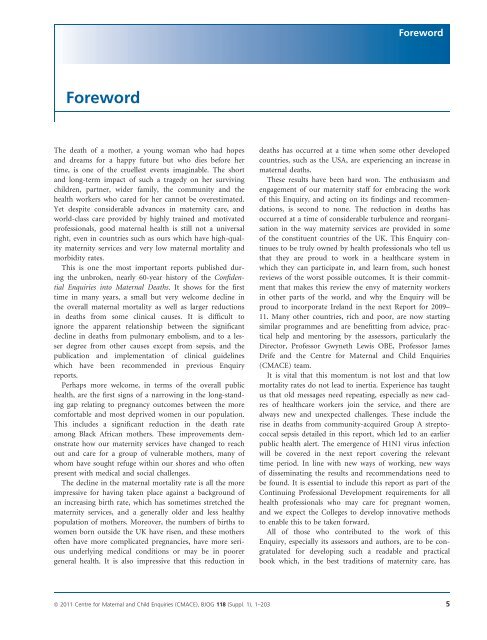6.-March-2011-Saving-Mothers-Lives-reviewing-maternal-deaths-to-make-motherhood-safer-2006-2008
6.-March-2011-Saving-Mothers-Lives-reviewing-maternal-deaths-to-make-motherhood-safer-2006-2008
6.-March-2011-Saving-Mothers-Lives-reviewing-maternal-deaths-to-make-motherhood-safer-2006-2008
You also want an ePaper? Increase the reach of your titles
YUMPU automatically turns print PDFs into web optimized ePapers that Google loves.
ForewordForewordThe death of a mother, a young woman who had hopesand dreams for a happy future but who dies before hertime, is one of the cruellest events imaginable. The shortand long-term impact of such a tragedy on her survivingchildren, partner, wider family, the community and thehealth workers who cared for her cannot be overestimated.Yet despite considerable advances in maternity care, andworld-class care provided by highly trained and motivatedprofessionals, good <strong>maternal</strong> health is still not a universalright, even in countries such as ours which have high-qualitymaternity services and very low <strong>maternal</strong> mortality andmorbidity rates.This is one the most important reports published duringthe unbroken, nearly 60-year his<strong>to</strong>ry of the ConfidentialEnquiries in<strong>to</strong> Maternal Deaths. It shows for the firsttime in many years, a small but very welcome decline inthe overall <strong>maternal</strong> mortality as well as larger reductionsin <strong>deaths</strong> from some clinical causes. It is difficult <strong>to</strong>ignore the apparent relationship between the significantdecline in <strong>deaths</strong> from pulmonary embolism, and <strong>to</strong> a lesserdegree from other causes except from sepsis, and thepublication and implementation of clinical guidelineswhich have been recommended in previous Enquiryreports.Perhaps more welcome, in terms of the overall publichealth, are the first signs of a narrowing in the long-standinggap relating <strong>to</strong> pregnancy outcomes between the morecomfortable and most deprived women in our population.This includes a significant reduction in the death rateamong Black African mothers. These improvements demonstratehow our maternity services have changed <strong>to</strong> reachout and care for a group of vulnerable mothers, many ofwhom have sought refuge within our shores and who oftenpresent with medical and social challenges.The decline in the <strong>maternal</strong> mortality rate is all the moreimpressive for having taken place against a background ofan increasing birth rate, which has sometimes stretched thematernity services, and a generally older and less healthypopulation of mothers. Moreover, the numbers of births <strong>to</strong>women born outside the UK have risen, and these mothersoften have more complicated pregnancies, have more seriousunderlying medical conditions or may be in poorergeneral health. It is also impressive that this reduction in<strong>deaths</strong> has occurred at a time when some other developedcountries, such as the USA, are experiencing an increase in<strong>maternal</strong> <strong>deaths</strong>.These results have been hard won. The enthusiasm andengagement of our maternity staff for embracing the workof this Enquiry, and acting on its findings and recommendations,is second <strong>to</strong> none. The reduction in <strong>deaths</strong> hasoccurred at a time of considerable turbulence and reorganisationin the way maternity services are provided in someof the constituent countries of the UK. This Enquiry continues<strong>to</strong> be truly owned by health professionals who tell usthat they are proud <strong>to</strong> work in a healthcare system inwhich they can participate in, and learn from, such honestreviews of the worst possible outcomes. It is their commitmentthat <strong>make</strong>s this review the envy of maternity workersin other parts of the world, and why the Enquiry will beproud <strong>to</strong> incorporate Ireland in the next Report for 2009–11. Many other countries, rich and poor, are now startingsimilar programmes and are benefitting from advice, practicalhelp and men<strong>to</strong>ring by the assessors, particularly theDirec<strong>to</strong>r, Professor Gwyneth Lewis OBE, Professor JamesDrife and the Centre for Maternal and Child Enquiries(CMACE) team.It is vital that this momentum is not lost and that lowmortality rates do not lead <strong>to</strong> inertia. Experience has taughtus that old messages need repeating, especially as new cadresof healthcare workers join the service, and there arealways new and unexpected challenges. These include therise in <strong>deaths</strong> from community-acquired Group A strep<strong>to</strong>coccalsepsis detailed in this report, which led <strong>to</strong> an earlierpublic health alert. The emergence of H1N1 virus infectionwill be covered in the next report covering the relevanttime period. In line with new ways of working, new waysof disseminating the results and recommendations need <strong>to</strong>be found. It is essential <strong>to</strong> include this report as part of theContinuing Professional Development requirements for allhealth professionals who may care for pregnant women,and we expect the Colleges <strong>to</strong> develop innovative methods<strong>to</strong> enable this <strong>to</strong> be taken forward.All of those who contributed <strong>to</strong> the work of thisEnquiry, especially its assessors and authors, are <strong>to</strong> be congratulatedfor developing such a readable and practicalbook which, in the best traditions of maternity care, hasª <strong>2011</strong> Centre for Maternal and Child Enquiries (CMACE), BJOG 118 (Suppl. 1), 1–203 5


